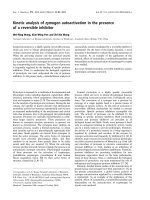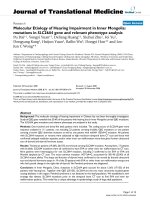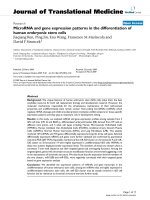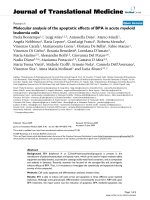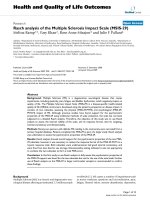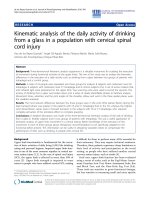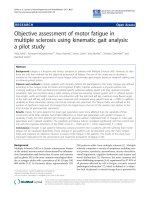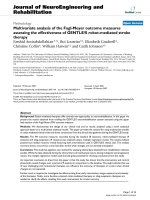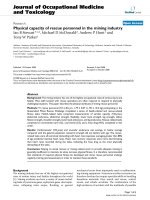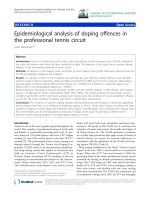báo cáo hóa học: " Epidemiological analysis of doping offences in the professional tennis circuit" pptx
Bạn đang xem bản rút gọn của tài liệu. Xem và tải ngay bản đầy đủ của tài liệu tại đây (227.9 KB, 6 trang )
RESEARC H Open Access
Epidemiological analysis of doping offences in
the professional tennis circuit
Javier Maquirriain
1,2
Abstract
Introduction: Tennis is a professional sport under a strict anti-doping control. However, since the first violation of
the code, the positive cases have not been statistically studied. The objective of this study was to analyze doping
offences in the international professional tennis circuit.
Methods: All offences to the Doping Code committed by tennis players during 2003-2009 were collected from the
ITF official webpage, registered and analyzed.
Results: An average of 1905.7 (±174.5) samples was obtained per year. Fifty-two doping offences were reported
and the overall incidence of positive doping samples accounted for 0.38% and 7.4 (±4.1) cases/year. Male players
showed higher incidence doping offences than females (p = 0.0004). The incidence in wheelchair players was
higher than in non-handicapped subjects (p = 0.0001)
Banned substance distribution showed: stimulants 32.6 9%, cannabis 23.07%; anabolic 11.53%, diuretics and masking
agents 11.53, b2-agonists 9.61%; corticosteroids 3.84%, others 3.84%. The overall incidence of ’social drugs’ (cocaine,
cannabis) was 36.53%. All EPO and blood samples were normal, while the incidence of ’out-of-competition’ offences
was 0.12 %. The lower incidence of doping was found in Grand Slams tournamen ts.
Conclusions: The incidence of positive doping samples among professional tennis players is quite low supporting
the assumption that there is no evidence of systematic doping in Tennis. “Social drugs” misuse constitutes the main
problem of doping in tennis. Male and wheelchair tennis players showed higher risk of infringing the doping code
than their females and non-handicapped counterparts. Findings of this study should help to determine the
direction of the ongoing strategy in the fight against dop ing in Tennis.
Introduction
Tennis is one of the most popular sports throughout the
world. The number of professional players, both male
and female, is continually increasing each year. At pre-
sent, there are 1794 male players who have ATP* singles
ranking [1] and 1106 women players who have WTA**
ranking [2]. The professional tennis circuit manages its
doping control through the Tennis Anti-Doping Pro-
gramme (TADP) which is an international comprehen-
sive drug-testing system that applies to all players who
hold an Associate Tennis Professionals (ATP) or
Women Tennis Association (WTA) ranking, or who are
competing at tournaments sanctioned by the Interna-
tional Tennis Federation (ITF), ATP, and WTA Tour.
This includes men’ sandwomen’stourevents,Grand
Slams, Fed Cup, Davis Cup, wheelchair and junior tour-
naments. The goals of the TADP are to maintain the
integrity of tennis and protect the health an d rights of
all tennis players [3]. The TADP maintains a common
set of rules and procedures that apply across all le vels of
tennis. Players are tested for banned substances in
accordance with the guidelines of the World Anti-Dop-
ing Agency (WADA) Code [4].
Drug testing conducted by the Men’s Tennis Council
began in the late 1980 s and focused on recreational
drugs. When the A TP Tour was formed in 1990, the
governing bo dy of the men’s professional tennis circuit
extended the testing to include performance-enhancing
drugs. The TADP began in 1993, with each of the three
bodies (ITF, ATP and WTA Tour) managing testing at
their own events, and dealing with any cases arising
from their tournaments. The TADP also conducted ‘out
of competition’ testing. Since 2007, the ITF has managed,
Correspondence:
1
High Performance National Sports Center, Buenos Aires, Argentina
Full list of author information is available at the end of the article
Maquirriain Journal of Occupational Medicine and Toxicology 2010, 5:30
/>© 2010 Maquirriain; licensee BioMed Central Ltd. This is an Open Access article distributed under the terms of the Creative Commons
Attribution License (http://cre ativecommons.org/licenses/by/2.0), which permits unrestricted use, distribution, and reproduction in
any medium, provided the original work is properly cited.
administrated and enforced the TADP at all tennis
events sanctioned. These include the Grand Slams, ATP
circuit, Sony Ericsson WTA Tour, Davis Cup and Fed
Cup, Challenger events, ITF Pro Circuit, and ITF Junior
and Wheelchair events.
Since the first anti-doping violation infringed by a
23-year old Spanish player i n a Challenger tournament
in 1996, only few short reports were published regarding
the positive cases [5,6].
The objective of this study w as to analyze doping
offences in the international professional tennis circuit.
*Association of Tennis Professional, ** Women Tennis
Association.
Methods
The 2009 WADA Code [4] defines ‘doping’ as the occur-
rence of one or more of the anti-doping rule violations,
such as: 1) presence o f a ‘prohibited substance’ ,orits
metabolites or markers in an athlete’ s sample; 2) use or
attempted use by an athlete of a ‘prohibited substance’ or
a ‘ prohib ited method’ ; 3) refusing or failing without
compelling justification to submit to sample collection;
4) violation of a pplicable requirements r egard ing athlete
availability for ‘out-of-competition’ testing; 5) tampering
or attempted tamper ing with any part of doping control;
6) possession of ‘ prohibited substances’ and ‘prohibited
methods’; 7) trafficking or attempted trafficking in any
‘prohibited substance’ or ‘prohibited method’; 8) adminis-
tration or attempted administration to any athlete ‘in-
competition’ of any ‘prohibited method’ or ‘prohibited
substance’ , or administration o r attempted administra-
tion to any athlete ‘out-of-competition’ of any ‘prohibited
method’ or any ‘ prohibited substance’ that is prohibited
‘out-of-competition’ , or assisting, encouraging, aiding,
abetting, covering up or any other type of complicity
involving an anti-doping rule violation or any attempted
anti-doping rule violation.
The ITF has publ ished the complete list of anti-doping
offences between 2003 an d 2009 [3]. According to the
doping definition, all offences to the WADA Code com-
mitted by tennis players that period were collected from
the ITF official webpage, registered and analyzed by sub-
stance, gender, nationality, and type of tournament.
Descriptive statistics were obtained and chi-square
tests were performed for comparing data from different
groups within samples (alfa 0.05; beta 0.2). Spearman test
was used for correlation analysis. (Statistical package:
Statistica for Windows, Statsoft® Tulsa, Oklahoma, USA).
Results
An average of 1905.7 ± 174.5 doping samples was
obtained per year: urine = 1725.1 ± 183.4; blood = 180.5
± 34.3 (Table 1). Fifty-two doping violations were
reported during 2003-2009 and the overall incidence of
positive doping samples accounted for 0.38% (52/13340).
The annual rate was 7.42 ± 4.11 ( range 2-14). Correla-
tion analysis of doping offences and number of samples
obtained per calendar year failed to show statistical sig-
nificance (p = 0.58, Spearman R: -0.2522).
Relative gender frequency of doping cases in profes-
sional tennis players was 86.53% (45/52) male and
13.46% female (7/52). Moreover, male tennis players
showed significant higher incidence of performing a
doping offence than female s (45 offences/8373 samples,
and 7/4967, respectively; chi-square = 12.6, p = 0.0004)
(Table 2). Mal e tennis p layers who commi tted doping
violations were older than their female counterparts
(27.35 ± 4.51 and 24.14 ± 4.59 years, respectively; p =
0.09, t-test for independent samples).
Prohibited substances founded in the doping controls
of tennis players during the 2003-2009 period showed
the following distribution: stimulants (S6) 32.69%, can-
nabis (S8) 23.07%; anabolic (S1) 11.53%, diuretics and
masking agents (S5) 11.53%, b2-agonists (S3) 9.61%; cor-
ticosteroids (S9) 3.84%, others 3.84% (Table 3). The over-
all incidence of ’ social drugs’ (cocaine, cannabis)
accounted of 36.53% (19/52) of all cases and none dop-
ing cases where found in neither ’blood samples’ nor
erythropoietin (EPO) analysis (0/1264 samples).
The TADP includes both, “in-competition” and “ out-
of-competition” tests. The average of “ in-competition”
and “ out-of-competition” tests obtained per year was
1791.2 ± 165.1 and 114.4 ± 37.0, respecti vely. The over-
all incidence of ’ out-of-competition’ positive cases was
0.12% (1/52), while the specific incidence account of
0.12% (1/801 ’out-of-competition’ samples).
The four Grand Slams tournaments (Australian Open,
Roland Garros , Wimbledon and US Open) are th e most
prestigious individual competitions in tennis. Most of
the doping controls 40.86% (5452/1334 0) were per-
formed during Grand Slams events and the incidence of
positive cases in such tourna ments was 0.18% (10/5452)
(Table 4). Usually blood tests and EPO tests are per-
formed in Grand Slams events exclusively. The Davis
Cup is the largest annual international male team com-
petition in sport, while the Fed Cup is the national
women team competition in tennis. In the present
study, 3.29% (440/13340) of doping controls were
obtained during Davis Cup matches, and 2.66% (355/
13340) in Fed Cup matches. All participants in Davis
cup and Fed Cup final ties were tested in the 2003-2009
period. The incidence of positive doping c ases in Davis
Cup male players was 0.68% (3/440); no Code violations
were reported in Fed Cup female participants (0/355)
(chi-square test 2,43; p = 0.11). The incidence of posi-
tive doping cases in Grand Slam tournaments (10/5452)
were significantly lower than in Davis Cup matches
(3/340), and other professional championships,
Maquirriain Journal of Occupational Medicine and Toxicology 2010, 5:30
/>Page 2 of 6
excluding wheel chair tournamen ts (34/7612), (p =
0.0082 and p = 0.00103, respectively) (Table 4).
The TADP also conducted controls in the professional
wheelchair tennis circuit at an annual average of 39.8
analyses (range 21-5 3). In the present study, 9.61% (5/
52) of all offences were committed by handicapped
players. Wheelchair tennis players showed a significant
higher incidence of doping offences than the non-handi-
capped players: 1.81% (5 violations/276 doping controls)
and 0.35% (47/13064) respectively (chi-square = 14.75,
p = 0.0001) (Table 5).
The present study showed that the majority of doping
offences were committed by European players (59.6%, 31/
52), followed by North Americans (15.3%, 8/52), South
Americans (15.3%, 8/52), Oceanians (5.7%, 3/52), Africans
(1.9%, 1/52), and Asian players (1.9%, 1/52). The most
affected countries were France (7 po sitive doping viola-
tions), USA (n = 6), Spain (n = 5), and Argentine (n = 5).
The average duration of sanctions for doping viola-
tions in the professional tennis circuit was 13.09 ± 15.35
months (range 0-96 months).
Discussion
The main finding of this study was the relative low inci-
dence (0.38%) of po sitive doping samples among
professional tennis players, especially for the true perfor-
mance enhancing drugs such as anabolic steroids and sti-
mulants supporting the assumption that there is no
evidence of systematic doping in Tennis. Tennis showed
similar doping incidence to those of other sports under
strict anti-doping control. The Fédération Internatio nale
de Football Association (FIFA) rep orted a 0.4% relative
incidence of positive samples of more than 20,000 con-
trols per yea r [7]. The incidence of doping cases in the
Olympic Games since the implementation of doping con-
trols (1968-2008) was 0.43% [8]; in Beijing 2008 the inci-
dence of positive cases were 0.19% (9/4470) but most of
the offences were due to anabolic consumption [8].
Male competitive tennis players showed significant
higher incidence of doping offences than female tennis
players. Similar results have been reported in others
sports. Male tennis players were noted to have more
risk-taking behavior than female players [9].
This study also confirmed that “social drugs” constitu-
tes the main problem of doping in tennis. As in most
other sports, most of doping violations in tennis are due
to cocaine and marijuana positive urine samples;
furthermore, its relative incidence se ems to be increas-
ing in last years [6]. Substance abuse among adolescents
and young adults remains an issue of concern in today’s
society. In the athletic environment, most problems
related with recreational drugs include alcohol, mari-
juana and cocaine consumption, while other less familiar
substances (heroin, gamma hydroxy butirate, etc.) are
seldom abused. Several studies have shown an impress-
ive increase in the frequency and quantity of marijuana
consumption, essentially in the younger population, with
an earlier onset of use [10]. Other article s have shown
noticeable differences between substance abuse in
athletes and non-athletes. For example, athletes showed
significant higher risk-taking behaviour than their non-
athletic peer. Athletes in contact and team sports
demonstrated higher risk of recreation al drug abuse
Table 1 Descriptive data of control samples and doping offences in the professional tennis circuit in the 2003-2009
period
Year N° offences* Samples* (total) Urine Blood In-Comp Out-Comp
2009 7 2126 1991 135 1972 154
2008 10 2018 1861 157 1927 91
2007 3 2028 1833 195 1871 157
2006 9 1733 1538 195 1583 150
2005 14 1744 1589 155 1654 90
2004 7 1698 1509 189 1620 78
2003 2 1993 1755 238 1912 81
Total 52 13340 12076 1264 12539 801
Average/year 7.4 ± 4.1 1905.7 ± 174.5 1725.1 ± 183.4 180.5 ± 34.3 1791.2 ± 165.1 114.4 ± 37.0
’In-Comp’: in competition testing; ‘Out-Comp’: out of competition tes ting.
* Correlation analysis of doping offences and number of samples obtained per calendar year failed to show statistical significance (p = 0.58, Spearman R: -0.2522).
Table 2 Analysis of gender differences within doping
infractions in the professional tennis circuit during the
2003-2009 period
Female Players Male Players p value
Total Samples 4967 8373
Sample Average/year 709.5 ± 178.0 1196.1 ± 91.3
Total Doping Offences 745
Doping Offences/year 1.0 6.4
Incidence Offences/
sample (%)
0.14 0.53 0.0004
Age Average of
Offenders
24.1 ± 4.5 27.3 ± 4.5 0.09
Maquirriain Journal of Occupational Medicine and Toxicology 2010, 5:30
/>Page 3 of 6
than athletes in non-contact and individual spo rts like
tennis [9,11,12]. Other risk factors include high psycho-
logical stress and lack of familiar support. Consequently,
regular sports participation does not prevent substance
abuse like marijuana. Data gathering from WADA-
accredited laboratories show that cannabis i s easily the
commonest drug leading to positive results in all sports
[11]. Cannabis is prohib ited in O lympics events since
1989 and in professional tennis since the ATP tour
signed the WADA code in 2002. We consider th at the
prohibition of marihuana usage in tennis has provided
clear benefits for players. In the daily practice, this rule
acts as a true restrain for players because they try to
reduce or avoid cannabis consumption in order to be
allowed for professional participation under the Anti-
Doping Code. Some other players had to retire from
professional competitions probably due to their addic-
tion to marihuana.
Alcohol consumption is not prohibited in tennis.
However, the dangerous increase in alcohol beverages
consumption observed among tennis pla yers of all ages
in last years should alert sports physicians due to the
intrinsic deleterious effects of ethanol, as well as of its
facilitating role for marijuana and cocaine misuse. The
WADA, the world governing body in doping, states that
“doping in sport results from a combination of indivi-
dual, cultural, societal, and physiological factors.
Prevention of doping in sport must be based on a clear
understanding of the c omplex nature of the problem and
the comprehensive mix of strategies needed to address
them successfully” [4]. Since 2001, WADA has com-
mitted 50 million dollars to research in the fight against
doping [4]. However, surprisingly none of the 186 pro-
jects supported by WADA was related to misuse of
social drugs in sports.
Another issue of concern is the increasing number of
“no n-i nt ent iona l” doping cases in sports [13,14]. Pluim
[5] reported that 67.5% of doping cases in tennis at
independent hearings accepted that ther e was no intent
to enhance performance. Nutritional supplements can
be a source of positive doping case as some supplements
contain prohibited substances without showing this on
their label [13]. With the number of false-positive dop-
ing cases steadily increasing, we should critically review
the products that are on the list of prohibited sub-
stances and focus on tho se that are truly perfo rmance -
enhancing and damaging to health [5].
The Tennis Anti-Doping Program h as been conduct-
ing ’out-of-competition’ testing since its creation in 1993.
The relative incidence of doping offences ’out-o f-compe-
tition’ was extremely low (0.12%, 1/801). Only one case
of such controls was reported when a 23- year old Span-
ish player refused to g ive a sample during a 2005 Chal-
lenger tournament in Italy. Recently, two Belgian players
Table 3 Summary of ‘prohibited substances’ found in doping controls samples of professional tennis players during
2003-2009 (n = 52)
Prohibited Substance Relative
Distribution
Drugs founded in urine analysis
Stimulants (S6) 32.6% caffeine, ephedrine, cocaine, pemoline, etilefrine, adrafinil, modafinil, isometheptene, nikethamide,
methylhexanamine
Cannabis (S8) 23.07% THC
Anabolics (S1) 11.53% clenbuterol, stanozolol, nandrolone
Diuretics & Masking
Agents (S5)
11.53% hydrochlorothiazide, finasteride, amiloride, canrenone
b2-agonists (S3) 9.61% salbutamol, terbutaline
Corticosteroids (S9) 3.84% betamethasone, triamcinolone, budesonide
Others Infractions 3.84%
Note: caffeine and finasteride are not banned by the 2010-WADA Code.
Table 4 Analysis of doping infractions in different professional tournaments during the 2003-2009 period
Grand Slams Davis Cup Fed Cup Other Tournaments Total
Total Samples 5452 440 355 6817 13340
Sample Average/year 778.8 62.8 50.7 973.8 1905.7 ± 174.5
Total Doping Offences 10 3 0 34 52
Doping Offences/year 1.42 0.42 0 4.8 7.4 ± 4.1
Incidence Offences/sample (%) 0.18
b
0.68
a-b
0
a
0.4 0.38
a
p = 0.11.
b
p = 0.0082.
Maquirriain Journal of Occupational Medicine and Toxicology 2010, 5:30
/>Page 4 of 6
were suspended because they failed to provide the
whereabouts information properly infringing the ’out-of-
competition’ rules.
More than 40% of all doping samples were obtained
during Grand Slam tournaments. The lower incidence
of doping cases was found during these physically and
mentally demanding events. We hypothesize that Grand
Slam tournaments are played only by true elite tennis
players who are more familiarized with anti-doping rules
and less prone to commit code violations.
Wheelchair tennis also has an international tour with
currently over 120 events taking place all over the world.
To be eligible to compete, a player must have a medically
diagnosed permanent mobility related physical disability,
which must result in a substantial loss of function in one
or both lower extremities. In the present study, wheel-
chair players showed a significant higher incidence of
doping violations than those non-handicapped players.
The five cases reported misuse of ma rijuana (3 cases),
cocaine (1 case) and modafinil plus adrafinil (1 case). The
education of players, coaches, and medical personnel in
contact with wheelchair tennis players must be rein-
forced in order to protect their health and the integrity of
this fast growing sport for handicapped subjects.
We a lso analyzed the nationality of doping offenders.
Most of violations were committed by European tennis
players. Europeans were also the more sanctioned ath-
letes in the all the Olympic Games (62%) [8]. The pre-
sent study showed that players from countries where
tennis is more popular providing high number of players
to the professional circuit (like France, USA, Spain and
Argentine), may be more prone to infringe de Anti-
Doping Code.
Despite the fact that the incidence of positive doping
cases among tennis players is low in comparison with
other sports, a stringent system of doping con trol is criti-
cal to the future in the sport. However, findings of this
study should help t o determine the nature and direction
of the ongoing strategy in the fight against doping in ten-
nis: 1) the overall incidence of doping offences is low; 2)
the abuse of EPO and growth hormone (GH) is null; 3)
the incidence of positive cases in ’out-of-competition’ test-
ing is null too; 4) there is lack of positive correlation
between the number of anti-doping controls and positive
cases. According to this scientific evidence, the cost-
effectiveness relationship of the TAD P should be review,
and more financial resources may be redire cted to differ-
ent areas of Sports Medicine.
In summary, this study showed that the incidence of
positive doping samples among professional tennis
players is quite low supporting the assumption that
there is no evidence of systematic doping in Tennis.
This study confirmed that “social drugs” misuse (mari-
juana and cocaine) constitutes the main problem of
doping in tennis. All ’out of competition’,EPOandGH
analysis were negative. Male and wheelchair tennis
players showed higher risk of infringing the doping code
than their females and non-handicapped counterparts.
Author details
1
High Performance National Sports Center, Buenos Aires, Argentina.
2
Argentine Tennis Association, Buenos Aires, Argentina.
Competing interests
The authors declare that they have no competing interests.
Received: 3 October 2010 Accepted: 15 December 2010
Published: 15 December 2010
References
1. Association of Tennis Professional. Ranking available at [http://www.
atpworldtour.com], (accessed 1° Apr 2010).
2. Women Tennis Association. Ranking available at [http://www.
sonyericssonwtatour.com], (accessed 1° Apr 2010).
3. International Tennis Federation. Data available at [tennis.
com/antidoping], (accessed 10 March 2010).
4. World Antidoping Agency. Code 2009 [],
(accessed 1° Apr 2010).
5. Pluim B: A doping sinner is not always a cheat. Br J Sports Med 2008,
42:549-550.
6. Maquirriain J, Baglione R: Marijuana consumption among professional
tennis players. J Med Sci Tennis 2009, 14:22-23.
7. Dvorak J, McCrory P, D’Hooghe M: FIFA’s future activities in the fight
against doping. Br J Sports Med 2006, 40(Suppl I):i58-i59.
8. Gracia-Marco L, Rey-López JP, Casajús Mallen JA: El dopaje en los Juegos
Olímpicos de verano (1968-2008). Apunts Med Sports 2009, 44:66-73.
9. Nattiv A, Puffer J: Lifestyles and health risks of collegiate athletes. J Fam
Pract 1991, 33:585-590.
10. Saugy M, Avois L, Saudan N, et al: Cannabis and sport. Br J Sports Med
2006, 40(Suppl I):113-115.
11. Alaranta A, Alaranta H, Holmila J, et al: Self-reported attitudes of elite
athletes towards doping: differences between types of sport. Int J Sports
Med 2006, 27 :842-846.
Table 5 Analysis of doping infractions in wheel-chair and non-handicapped tennis players during the 2003-2009
period
Non-handicapped players Wheel Chair Players Total
Total Samples 13064 276 13340
Sample Average/year 1866.2 39.4 1905.7 ± 174.5
Total Doping Offences 47 5 52
Doping Offences/year 6.7 0.7 7.4 ± 4.1
Incidence Offences/sample (%) 0.35
a
1.81
a
0.38
a
p = 0.0001.
Maquirriain Journal of Occupational Medicine and Toxicology 2010, 5:30
/>Page 5 of 6
12. Regier DA, Farmer ME, Rae DS, et al: Co-morbidity of mental disorders
with alcohol and other drug abuse. JAMA 1990, 264:2511-2514.
13. Yonamine M, Rogrigues Garcia P, Moraes Moreau RL: Non-intentional
doping in Sports. Sports Med 2004, 34:697-704.
14. De Hon O, Coumans B: The continuing story of nutritional supplements
and doping infractions. Br J Sports Med 2007, 41:800-805.
doi:10.1186/1745-6673-5-30
Cite this article as: Maquirriain: Epidemiological analysis of doping
offences in the professional tennis circuit. Journal of Occupational
Medicine and Toxicology 2010 5:30.
Submit your next manuscript to BioMed Central
and take full advantage of:
• Convenient online submission
• Thorough peer review
• No space constraints or color figure charges
• Immediate publication on acceptance
• Inclusion in PubMed, CAS, Scopus and Google Scholar
• Research which is freely available for redistribution
Submit your manuscript at
www.biomedcentral.com/submit
Maquirriain Journal of Occupational Medicine and Toxicology 2010, 5:30
/>Page 6 of 6
